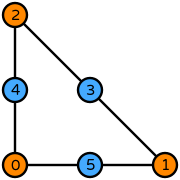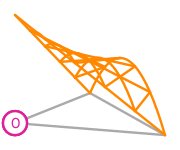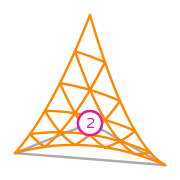an encyclopedia of finite element definitions
Degree 2 Morley–Wang–Xu on a triangle
◀ Back to Morley–Wang–Xu definition page
- \(R\) is the reference triangle. The following numbering of the subentities of the reference cell is used:
- \(\mathcal{V}\) is spanned by: \(1\), \(x\), \(x^{2}\), \(y\), \(x y\), \(y^{2}\)
- \(\mathcal{L}=\{l_0,...,l_{5}\}\)
- Functionals and basis functions:

\(\displaystyle l_{0}:v\mapsto v(0,0)\)
\(\displaystyle \phi_{0} = 2 x y - x - y + 1\)
This DOF is associated with vertex 0 of the reference cell.
\(\displaystyle \phi_{0} = 2 x y - x - y + 1\)
This DOF is associated with vertex 0 of the reference cell.
\(\displaystyle l_{1}:v\mapsto v(1,0)\)
\(\displaystyle \phi_{1} = \frac{x^{2}}{2} - x y + \frac{x}{2} - \frac{y^{2}}{2} + \frac{y}{2}\)
This DOF is associated with vertex 1 of the reference cell.
\(\displaystyle \phi_{1} = \frac{x^{2}}{2} - x y + \frac{x}{2} - \frac{y^{2}}{2} + \frac{y}{2}\)
This DOF is associated with vertex 1 of the reference cell.
\(\displaystyle l_{2}:v\mapsto v(0,1)\)
\(\displaystyle \phi_{2} = - \frac{x^{2}}{2} - x y + \frac{x}{2} + \frac{y^{2}}{2} + \frac{y}{2}\)
This DOF is associated with vertex 2 of the reference cell.
\(\displaystyle \phi_{2} = - \frac{x^{2}}{2} - x y + \frac{x}{2} + \frac{y^{2}}{2} + \frac{y}{2}\)
This DOF is associated with vertex 2 of the reference cell.
\(\displaystyle l_{3}:\mathbf{V}\mapsto\displaystyle \int_{e_{0}}\frac{\partial}{\partial\left(\begin{array}{c}\displaystyle 0\\\displaystyle 1\end{array}\right)}v\)
where \(e_{0}\) is the 0th edge.
\(\displaystyle \phi_{3} = y \left(1 - y\right)\)
This DOF is associated with edge 0 of the reference cell.
where \(e_{0}\) is the 0th edge.
\(\displaystyle \phi_{3} = y \left(1 - y\right)\)
This DOF is associated with edge 0 of the reference cell.
\(\displaystyle l_{4}:\mathbf{V}\mapsto\displaystyle \int_{e_{1}}\frac{\partial}{\partial\left(\begin{array}{c}\displaystyle -1\\\displaystyle 0\end{array}\right)}v\)
where \(e_{1}\) is the 1st edge.
\(\displaystyle \phi_{4} = x \left(x - 1\right)\)
This DOF is associated with edge 1 of the reference cell.
where \(e_{1}\) is the 1st edge.
\(\displaystyle \phi_{4} = x \left(x - 1\right)\)
This DOF is associated with edge 1 of the reference cell.
\(\displaystyle l_{5}:\mathbf{V}\mapsto\displaystyle \frac{\sqrt{2}}{2}\int_{e_{2}}\frac{\partial}{\partial\left(\begin{array}{c}\displaystyle - \frac{\sqrt{2}}{2}\\\displaystyle - \frac{\sqrt{2}}{2}\end{array}\right)}v\)
where \(e_{2}\) is the 2nd edge.
\(\displaystyle \phi_{5} = \frac{\sqrt{2} \left(- x^{2} - 2 x y + x - y^{2} + y\right)}{2}\)
This DOF is associated with edge 2 of the reference cell.
where \(e_{2}\) is the 2nd edge.
\(\displaystyle \phi_{5} = \frac{\sqrt{2} \left(- x^{2} - 2 x y + x - y^{2} + y\right)}{2}\)
This DOF is associated with edge 2 of the reference cell.





